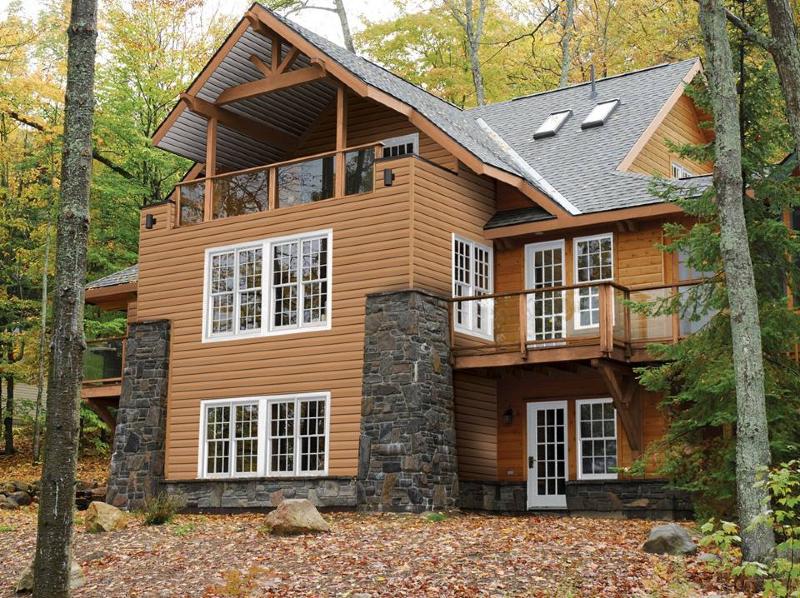
Types of Siding
Sidings contribute hugely to a home’s functionality. They protect the home from the elements and play a significant role in defining the home’s aesthetic appeal.
So if you’re a homeowner looking to give your house a fresh look or just curious about the options available, understanding the various types of siding is a great place to start. In this article, we’ll explore the different siding options.
We’ll break down the options straightforwardly, so you can make an informed decision for your home.
Vinyl siding
Due to its popularity and affordability, vinyl siding is a common choice for homeowners. This synthetic material, composed of PVC and additives, offers various styles and colors to suit your home.
The horizontal lap siding type provides a modern aesthetic, while vertical panels offer an alternative look. Vinyl siding stands out for its low maintenance, requiring no painting or treatment. It can also withstand harsh weather conditions like heavy rainfall, snow, and wind.
However, some critics dislike vinyl siding because it lacks the natural charm of wood or fiber cement siding, and its color may fade with sun exposure. Additionally, it doesn’t provide as much insulation.
Natural wood siding
Natural wood siding offers an authentic and timeless charm that synthetic materials strive to emulate but can never fully capture. Commonly crafted from cedar, pine, redwood, cypress, or spruce, each wood type imparts its unique character to your home’s exterior.
However, despite its enduring appeal, natural wood siding presents both pros and cons.
On the plus side, it exudes a classic and enduring elegance resilient against the elements. Yet, it demands diligent maintenance, including regular staining and sealing to shield against moisture-induced warping and rot.
So if you want to install wood siding, you should consider the cost of upkeep plus the initial cost of installation.
Additionally, wood siding carries a fire risk due to its combustible nature. However, proper care can grace your home for two to four decades before requiring replacement. This makes it a timeless investment.
So, while natural wood siding demands commitment, its enduring beauty and character make it a compelling choice for those seeking an authentic home exterior.
Metal siding
Metal siding has been gaining popularity in residential homes for good reasons. Apart from being just functional for roofs, it is also used for sidings.
But as usual, the metal material requires a high upfront cost. Thankfully, its exceptional durability and longevity make it a wise investment.
Metal siding is also an eco-friendly choice, as it is entirely recyclable. This makes it an eco-friendly choice any time, time, or day.
However, it can be prone to rust (for steel) or dents (for aluminum). So you may want to be careful about the items that come in contact with the material.
Fortunately, termites and rodents won’t be part of the elements you would be worried about, as they won’t be able to nibble on your siding. Generally, metal sidings resist elements like pests, mold, and fire.
Whether aluminum or steel, metal siding offers modern aesthetics and comes in various styles. It stands strong against harsh weather but may dent or scratch over time.
While it may not be the best insulator, it requires minimal maintenance, making it a compelling option for homeowners seeking a long-lasting, low-maintenance exterior.
Fiber cement siding
Fiber cement siding stands out as a durable and versatile choice, offering the appearance of vinyl, cement, or wood siding while surpassing longevity.
Crafted from a blend of cement, wood pulp, and other components, it blends the sturdiness of cement with aesthetic flexibility. It’s a 30-year investment that can remain resilient against hail and strong winds in intense climates.
While fiber cement can mimic the texture of wood, its installation costs more due to labor requirements, but the investment pays off in enduring curb appeal. Its resistance to fire, termites, and rot sets it apart.
Though it can be pricier than vinyl, it falls within the middle range, making it a valuable choice for homeowners seeking both durability and versatility in siding.
Brick siding
Brick siding, also known as brick veneer, captures the timeless charm of traditional brick construction without the hefty cost. It is often crafted from thin layers of real brick or polyurethane molded to mimic brick.
This siding offers a durable eco-friendly choice. Since they are made from clay and shale and readily available and recyclable materials. In terms of durability, brick sidings are also excellent. They can withstand the harshest weather conditions and remain in good shape.
An added perk is the ability to coordinate your home’s landscaping elements with your brick siding. This makes it possible to elevate your home’s aesthetics while protecting your abode from the elements.
However, like any siding, brick has its drawbacks. Over time, the mortar may deteriorate, requiring occasional maintenance.
Installation can also be costlier due to additional support requirements. Still, the enduring appeal brick siding offers makes it a beloved choice among homeowners.
Conclusion
For top-quality cedar siding that enhances your home’s appeal and withstands the test of time, look no further than Longhouse Cedar. Our commitment to eco-friendly, sustainable materials ensures you always get a lasting and environmentally conscious solution.
Contact us today to explore our wide range of cedar siding options and elevate your home’s aesthetic appeal.
